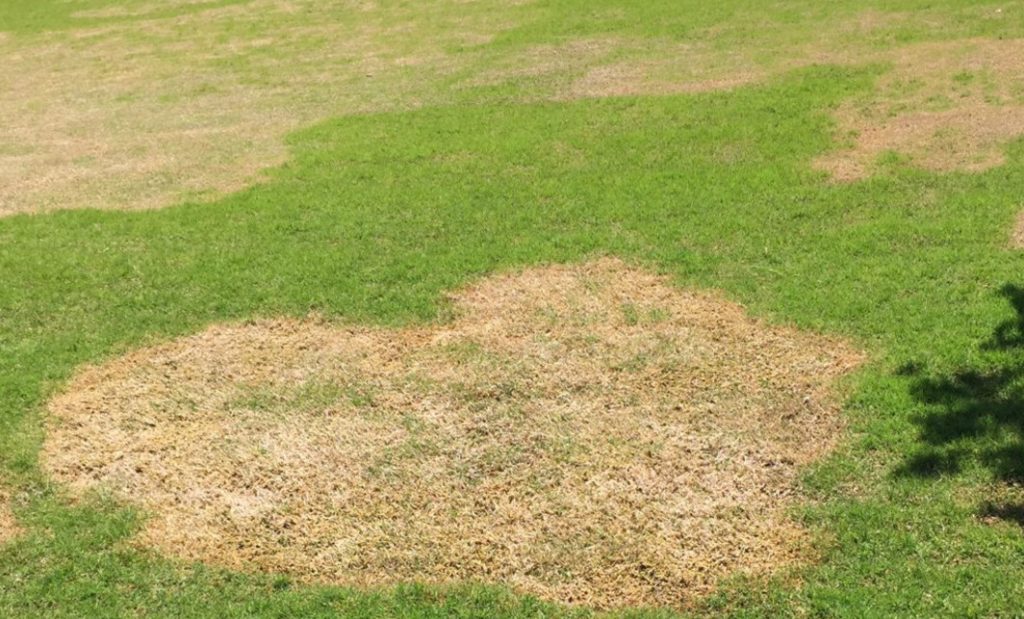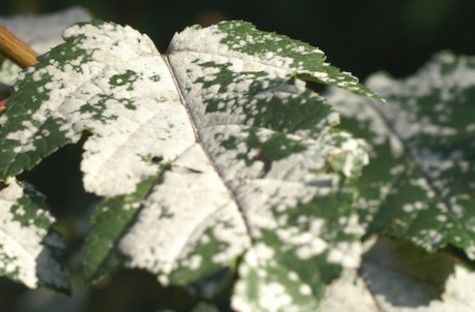As spring warms its way through North Texas, and ushers in the rainy season, replete with its torrential downpours, the familiar adage “April showers bring May flowers” is bound to come to mind. And though the promise of beautiful blooming gardens may help get you through the cloudy rainy days, that popular adage neglects to mention the hazards such days present to your lawn, shrubs, trees, and any other plants adorning your yard. While it’s true that rain is overall very beneficial (no one wants a drought!), excess water mixed with mild weather and gray skies are a perfect recipe for fungus and mildew to prevail, causing significant, and sometimes permanent, damage to your beloved yard.
Now when you hear the term fungus your first thought is probably of some sort of mushroom, whether that be a baby bella you get from the store or the kind that pop up in yards this time of year, but the visible mushrooms are only a small part of the wide world of fungi. Likewise, when you hear mildew, you probably envision the black stuff that likes to grow on shower tile grout, but the mildew that threatens your yard is a whole different beast, with different signs and treatments needed. Below we will take a look at some of the common fungi and mildew that can plague your yard, but a good rule of thumb is if you are seeing damage to your lawn, trees, bushes, or plants that you can’t easily explain, it’s better to call an expert from The Bug Dude @ 800-310-BUGS (2847) immediately to identify and treat the issue rather than risk permanent damage or death of the affected part(s) of your yard.

What are Some Common Fungus and Mildew Diseases?
When it comes to making a list of the afflictions that can attack the various plants in a yard in North Texas, there are a daunting number of choices, even if you narrow it down to just fungi and mildew. Below are four primary categories of fungal and mildew afflictions and a few of the common diseases within each category.
Root Rots
- Cotton Root Rot (fungus)
- Caused by one of the most destructive fungal organisms for plants.
- Attacks more than 2,000 species of plants, particularly ornamental plants (plants that are grown for display rather than function) and fruit/nut/shade trees.
- Only exists in the southwestern U.S.
- Symptoms occur when soil temperatures reach 82 degrees.
- Permanent damage occurs by the 3rd day and death of the plant follows soon after.
- The fungus grows continually through the affected soil moving from plant to plant and can be transported on the roots of infected plants. It can survive in the soil for many years.
- Mushroom Root Rot (fungus)
- Attacks orchard trees, shade trees, and shrubs.
- Occurs most frequently in wooded areas and recently cleared land, and to trees that have undergone other stressors (i.e. drought, flood, repeated defoliation by insects, etc.).
- Lawn grass sod growing too close to a tree or shrub can also aid in the susceptibility of the plant to this fungal infection.
- Generally leads to the death of the plant.
- Stem and Root Rot (fungus)
- These fungi cause fibrous root tips to decay.
- Particularly likely to infect plants that are over-watered, crowded, and injured.
- Once symptoms are observed, the damage done is usually severe.
Patches
- Anthracnose (fungus)
- Attacks grasses, particularly Common Bermuda, Buffalo Grass, and St. Augustine Grass.
- Leads to the eventual death of the plant.
- Brown Patch (fungus)
- Attacks several types of grass including Hybrid Bermuda, Common Bermuda, and St. Augustine Grass.
- The appearance of this fungus varies depending on the type of grass (cool vs warm season grasses) as well as environmental conditions.
- Patches develop in the fall, winter, and spring as grasses enter and emerge from dormancy.
- Favorable conditions also include cool evening temperatures (below 68 degrees), moderate daytime temperatures (between 75 and 85 degrees), and higher rainfall.
- Rots the leaf sheaths, making them easy to pull off.
- Take-all Patch (fungus)
- Attacks several types of grass, including Hybrid Bermuda, Common Bermuda, and St. Augustine Grass.
- The fungus is most active in fall and winter, but symptoms are noticed in late spring and early summer when the stressors of high temperatures and dry weather are first experienced.
- Can destroy large sections of turf grass if not controlled.
- Roots can become so rotted that the stolons (stems) can be easily pulled from the ground.
- Regrowth into afflicted areas is slow and often unsuccessful.
Mildews
- Downy Mildew
- Attacks St. Augustine Grass.
- It will disfigure the grass and stunt growth.
- Powdery Mildew
- Attacks Perennial Ryegrass and Poa Series Grass.
- Spreads quickly in shaded areas.
- Repeated infestations will kill the plants.
Spots
- Gray Leaf Spot (fungus)
- Attacks St. Augustine Grass.
- Favorable conditions include excess moisture, warm temperatures, and shaded areas.
- The disease develops rapidly under favorable conditions.
- Necrotic Ring Spot (fungus)
- Attacks Bentgrass, Fescue, and Poa Series Grass.
- Presents mostly in the the spring, where it will fade as summer approaches, only to reappear when the stressors of heat and drought hit.
- Roots, along with other sections of the plant, will rot, causing the plants to be easily removed from the turf.

What do Fungus and Mildew Look Like in a Yard?
Unlike the noticeable mushrooms that we are all very familiar with, many of the fungi and mildew that attack your yard are best observed through the damage they do rather than their own distinct forms. Below are the visual expressions of the diseases listed in the above section. If you notice any of these symptoms in your yard, call The Bug Dude at 800-310-BUGS (2847) immediately to get an expert to examine the issue before it progresses, as many of the infections can ultimately be fatal to the plant.
Root Rots
- Cotton Root Rot
- Begins as a slight yellowing/bronzing of the leaves and progresses to wilting upper leaves within 48 hours. Within 72 hours, lower leaves will also wilt.
- Affected plants can easily be pulled from the soil; their roots are brown and decayed with bronze-colored strands of the fungus on the root surface.
- Mushroom Root Rot
- Initial symptoms can range from a slow decline to rapid death, with a gradual decline leading to death being most common.
- Dead areas occur in the bark on the main stem and large roots near the soil surface. The white fungal growth can be seen over the surface of the wood when the dead bark is peeled back.
- Stem and Root Rot
- Spots varying in color from gray, brown, black, or red, occur on the stem and roots near the soil level.
- Common symptoms include wilting and poor vigor.
Patches
- Anthracnose
- Irregularly shaped patches ranging in size from several inches to many feet in diameter.
- Patch color begins as reddish brown and goes to tan.
- Occasionally causes the same colored spots on leaves.
- Tiny black acervuli, which look like spiked spheres, form in dead leaves and stems.
- Brown Patch
- Circular or irregular patches of thinned light brown grass; patches can be up to several yards in diameter.
- A darker border, or smoke ring, may develop along the perimeter of the patch.
- An active infection will present with yellow leaves at the edges of the patch.
- Take-all Patch
- The initial symptom is usually yellow leaves that will eventually die.
- The turf then becomes thin as the disease spread to the roots and the plants die.
Mildews
- Downy Mildew
- Visible powdery growth on the lower leaf surface.
- White or yellowish lines running parallel to the leaf veins.
- Leaves will turn yellow and the tips may turn brown.
- Powdery Mildew
- Grayish-white growth on the upper surface of leaves and leaf sheaths.
- Infected leaves turn yellow and slowly die.
Spots
- Gray Leaf Spot
- Causes severe thinning of the turf.
- Brown or ash colored spots with purple or brown margins appear on leaves. As the spots grow they become diamond-shaped.
- Grass may appear burned or scorched in appearance as the spots grow and leaves die.
- Necrotic Ring Spot
- Creates circular patches over a foot in diameter.
- Initial symptoms are purplish, wilted leaves.
- As plants die they will turn straw colored.
- Older patches (2 or 3 years old) can start to have new growth in the middle of the affected area.
How do you Prevent Fungus and Mildew?
When it comes to protecting your yard from the damaging effects of fungus and mildew there are a few main tips that will help prevent just about every disease mentioned above.
- Most importantly: at the first signs of disease call The Bug Dude at 817-354-5350 to have our experts evaluate the affected plants to determine the cause of the affliction and get it treated immediately before the infection can worsen or spread.
- Water plants and yards in the early morning before the sun is out.
- Water turf deeply but rarely.
- Maintain proper fertility of the soil for the plants in your yard.
- Avoid over-fertilization in the spring and fall.
- Aerate the soil annually.
- Maintain a good drainage system for your yard.
- Avoid applying high rates of nitrogen during the summer.
- Be especially cognizant of moisture levels and aeration in shaded areas of the lawn.
- Promptly remove grass clippings from the yard.
- Place plants in sunny areas as much as possible.
- Maintain good air circulation throughout your yard.
- When mowing, don’t cut more than 1/3 of the leaf blade.
What Should you do if you see Signs of Fungus or Mildew?
At the first signs of damage to your lawn, trees, shrubs, or other yard plants, call The Bug Dude at 817-354-5350 to get one of our certified technicians out to diagnose and treat the issue. Not only do several different types of fungal and mildew infections present with a similar appearance, but many pest infestations can cause damage that can be difficult to distinguish from other types of plant deterioration (see our article on common yard pests here), and having an expert’s treatment can save you time and money, and ultimately can mean the difference between saving the life of your plants and watching them die. So this spring as the rains and clouds approach, be mindful of the conducive conditions in your yard and don’t let fungi and mildew ruin the beauty of your outdoor oasis.
Further Reading:
“Problems Affecting Multiple Crops” – Texas Plant Disease Handbook – Texas A&M AgriLife Extension
“Lawn & Turf” – Texas Plant Disease Handbook – Texas A&M AgriLife Extension
“Shrubs” – Texas Plant Disease Handbook – Texas A&M AgriLife Extension
“Trees” – Texas Plant Disease Handbook – Texas A&M AgriLife Extension
“Powdery Mildew on Ornamentals” – W. D. Gubler, Plant Pathology, UC Davis; S. T. Koike, UC Cooperative Extension, Monterey Co. – UC Statewide IPM Program, University of California, Davis.
Author Bio: Alissa Breach has been gaining knowledge and experience around pest control concerns over the last 12 years while working for Mid-Cities Pest Control. She has a creative writing BA from UW-Madison and is always pursuing new and interesting writing projects.




